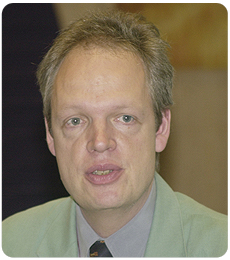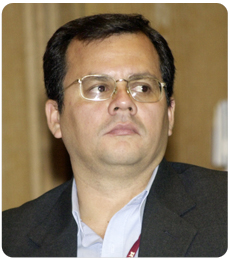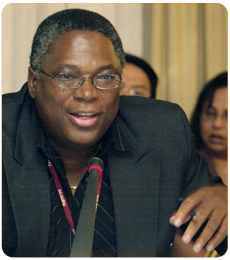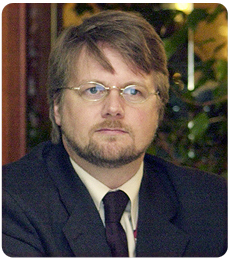|
|
|
|
|
|
Who is interested in CDM afforestation and reforestation projects?
Presented by the German Association for Emissions Trading and Climate Protection
|
|
 |
|
|
|
Igino Emmer, Face Foundation, introduced ENCOFOR, a EU-funded initiative promoting sustainable CDM forestry projects.
Bart Muys, Leuven Catholic University, highlighted three co-benefits of CDM A&R projects: forest products, including timber, fuel wood, and non-wood forest products; social benefits, including increased employment, change in migration patterns and poverty reduction; and environmental benefits, including soil conservation, improved microclimate and reduced deforestation. Muys emphasized unsustainable plantation management and soil degradation after clear-cutting as risks. In conclusion, Muys acknowledged that trade-offs between benefits and costs need to be assessed and that careful project design is required.
Michael Dutschke, Hamburg Institute of International Economics, discussed making long-term Certified Emission Reductions (lCERs) compatible with national emissions trading systems. He concluded that: the EU is unlikely to oppose sinks; Joint Implementation (JI) forestry is unavoidable; integration of lCERs in the EU Emission Trading System is possible; and lCERs come closer to CER value than tCERs.
Bernhard Schlamadinger, Joanneum Research, explained that as small-scale CDM A&R projects entail a greater fluctuation of carbon stocks, some, if not all, tCERS and lCERS must be replaced after harvesting. Schlamadinger suggested "normal forest" operations as an option to reduce the fluctuation, but recognized that it may not be feasible for small-scale projects. He highlighted that "average carbon-stock accounting" is a second option that could: reduce the transaction costs of small-scale projects; maintain the environmental integrity of accounting; and eliminate the problem of accounting for fluctuation.
In response to a question about whether average carbon stock accounting would contradict the requirements of CDM credits, Schlamadinger said that for small-scale projects, the language could perhaps be more liberally interpreted.
Juan Garcia, Leuven Catholic University, discussed non-carbon dioxide (CO2) greenhouse gas emissions from CDM A&R projects. Recalling that environmentally sustainable CDM A&R projects ought to release only minimal amounts of non-CO2 greenhouse gases if at all. Garcia demonstrated through a study on tropical agriculture, that nitrous oxide and methane emissions from land use, land-use change and forestry (LULUCF) projects amount to only a small fraction of CO2 emissions. He said that non-CO2 emissions are greater in tropical wetlands than in boreal zones. He concluded that emission estimates must take into account climate zones, soil types, and land-use practices such as fertilization, and stressed that emission factors are highly uncertain.
In the ensuing discussion, when asked whether sequestration credits could be obtained for the reduction of methane and nitrous oxide emissions, Garcia responded that the credits could not be claimed because of their high level of uncertainty.
Timm Tennigkeit, Unique Forestry Consultants, described the benefits of small-scale CDM A&R projects by highlighting a case study in Uganda. He explained that the programme’s objectives were to diminish poverty in rural areas, decrease stress on natural forests, and mitigate a timber and fuel wood shortage. Tennigkeit concluded that, in Uganda, CDM A&R projects are only viable if both carbon credits and other forest products are produced, and stressed that in order to reach a sustainable project size, small-scale projects must be clustered.
|
|
|
Michael Dutschke, Hamburg Institute of International Economics, compares the risks and opportunities of temporary and long-term CERs, and explains how to create CER value from lCERs.
|
|
 |
|
|
Juan Garcia, Leuven Catholic University, concludes that LULUCF Good Practice Guidance default emission factors are useful for country reports but not for project-based estimations.
|
|
|
 |
|
|
|
|
|
|
|
|
|
|
|
|
CDM Executive Board: Question and answer session
Presented by the UN Framework Convention on Climate Change (UNFCCC)
|
|
 |
|
John Kilani, Clean Development Mechanism (CDM) Executive Board (EB) Chair, summarized the work of the CDM EB undertaken since the UNFCCC’s ninth Conference of the Parties and introduced the new EB members. He noted that nine out of the 13 methodologies approved by the EB are publicly available, 29 projects are available for public comments, four Applicant Entities (AEs) have been accredited, and 63 Designated National Authorities (DNAs) are in place. He also highlighted the new consolidated approach to methodologies adopted by the EB and their work on the Afforestation and Reforestation (A&R) Project Development Document.
In the ensuing discussion, a participant asked how the new consolidated approach to methodologies could help decrease the EB’s workload. Jose Miguez, CDM EB, replied that deliberations were still ongoing and that they would be accepting public inputs from 16-30 June, 2004 on the UNFCCC CDM website. Kilani added that once there is a final decision regarding consolidated methodologies, the relationship between the existing and approved methodologies could be determined. In response to a question on the nature of disclaimers that could be used by validators and verifiers (AE and Designated Operational Entities (DOE)), Kilani noted that DOEs could not be held responsible for the information available to them. He also stated that out of 13 project scopes, 11 have accredited DOEs and eight areas have approved methodologies.
Another participant asked whether there are requirements for CDM projects that concern only Non-Annex 1 Parties, to which Kilani responded that the EB has not discussed such projects specifically. He also said that questions relating to the date for the first issuance of certified emission reductions (CERs) should be directed to project participants and DOEs, not the EB. Responding to a request on whether the EB could provide some guidance to DNAs regarding foreign direct investments through the CDM, Sushma Gera, CDM EB, noted that DNAs should operate under the national regulatory framework and that such an effort would go beyond the EB’s mandate. Responding to a participant’s concern about the limited "windows of opportunity" for the CDM, Kilani said this is not a widely shared viewpoint. Another question was raised regarding potential problems faced by the EB over the next few years. Kilani summarized that the biggest challenges would be the overload of work and the need to ensure a good regional balance of projects. Responding to concerns regarding the delay in approving methodologies, Georg Borsting, CDM EB, emphasized that approving methodologies is a learning process and therefore takes time.
|
|
John Kilani, CDM EB Chair, expresses pleasure at the growing interaction of stakeholders in the EB’s work.
|
|
 |
|
Georg Borsting, CDM EB, stresses that the task of reviewing methodologies is a challenging one.
|
|
|
|
|
|
|
|
|
|
|
|
|
|
|
|
|
|






